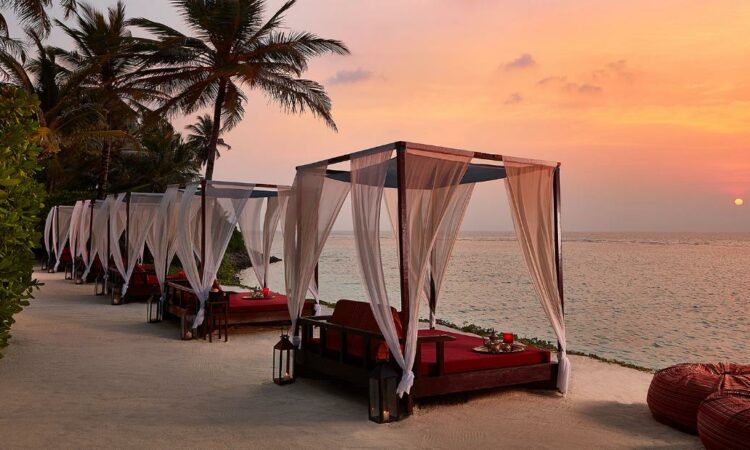In most destinations, being a million tourists short over the previous year would be a huge cause for concern, the result of a horrible natural disaster. But that was before 2020, and before the coronavirus pandemic changed the way we travel forever.
The Maldives, an Indian Ocean island archipelago practically synonymous with romance, normally sees north of 1.7 million visitors per year. In 2020, it had around 500,000. And despite the significant decrease, it marks one of the most successful tourism stories amid the pandemic.
Load Error
While many other destinations slammed their borders closed, the Maldives chose to fully reopen to travelers from any country, regardless of the status of the virus there, in July 2020.
Part of the decision was financial. According to data from Michigan State University, tourism contributes 28% of the Maldives’s GDP, one of the highest totals in the world.
The country’s geography also lends itself well to coronavirus protocols. Many hotels and resorts are on their own private islands — there are more than a thousand to choose from, even before man-made islands come into the equation — which makes isolating and social distancing exceptionally easy.
Countries around Asia and the Pacific have been more cautious about reopening than those in Europe and North America, meaning that tourists in the region had few options for places to go.
As other popular Asia-Pacific island getaways like Tahiti, Bali and Phuket remained off-limits, the Maldives took advantage of the fact that they were in relatively good shape with the virus. The places that have since reopened have done so with significant caveats. For example, Thailand and Sri Lanka both require a mandatory two-week hotel quarantine before being able to travel elsewhere in-country.
Understandably, there were some hiccups. The Maldives reopened unconditionally in July, only to walk it back in September by requiring all travelers to show proof of a negative Covid-19 test upon arrival.
The Maldives’ heavy reliance on ultra-luxury resorts also worked in its favor when it came to testing and social distancing. For example, some high-end properties conduct additional in-resort Covid testing as an added layer of protection against the spread of the virus.
Thoyyib Mohamed is the managing director of the Maldives Marketing & PR Corporation, the country’s national tourism authority.
He says that the country received a total number of 555,494 visitors in 2020, surpassing their adjusted arrival forecast of 500,000 arrivals by the end of 2020.
“Our biggest advantage is the unique geographical features of Maldives,” he says, adding that the implementation of strict hygiene protocols combined with the ease of spreading people on different islands made a compelling combination for travelers who wanted to get away from it all.
“We promoted the destination as a safe haven to the tourists.”
Infrastructure played a role as well. Many resorts have private boat or plane transfers built into their packages, meaning that visitors who arrived in the country could get to their final destinations without encountering many — if any — other tourists.
Jan Tibaldi, general manager of the One&Only Reethi Rah, tells CNN Travel that while they didn’t have significantly more visitors in 2020 than they did in 2019, there was a massive increase in the amount of time these visitors were spending there.
“Our guests are traveling less frequently, but for longer and with more purpose,” she said.
As a direct response to the increased amount of time visitors were spending in the Maldives and the fact that most people were going digital-only for work and school, the resort devised a special package for guests staying a full month. The 28-day offering includes meals, high-speed internet, wellness activities and use of a kids’ club and is priced from $42,600 for a family of four.
They weren’t the only ones. The Anantara Veli dug in even further, selling “all you can stay” packages for unlimited bookings for up to a year at a cost of $30,000. Another luxurious property, The Nautilus Maldives, promoted a “workation” package priced from $23,250 for seven days.
Still, there’s no such thing as a completely positive travel story when it comes to navigating the new world under Covid.
The Maldives closed its borders in late March, with about 500 total tourists still remaining in the country.
Many Maldivians who work in hospitality found themselves effectively “stranded in paradise,” forced to stay at the resorts where they worked in order to look after just a handful of guests.
Two staff members at the Kuredu Island Resort & Spa tested positive for the virus in March 2020. As a precaution, the entire resort was locked down. While quarantining on a postcard-pretty tropical beach wasn’t the worst possible scenario for the guests, it wasn’t as dreamy for the staff members who were charged with keeping the place running indefinitely.
However, the numbers alone show that despite reopening the Maldives has been able to keep the pandemic largely in check.
As of February 2021, the country has had 17,828 confirmed cases and just 58 deaths.
Source: Read Full Article

